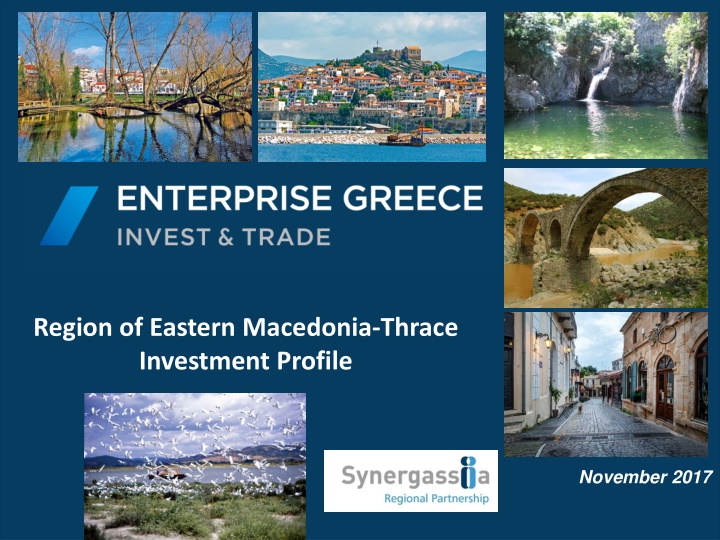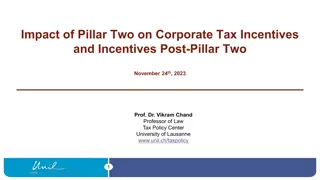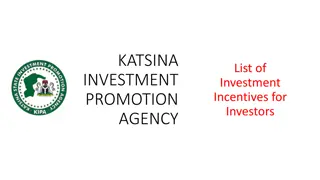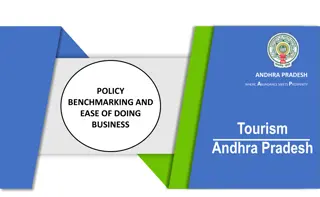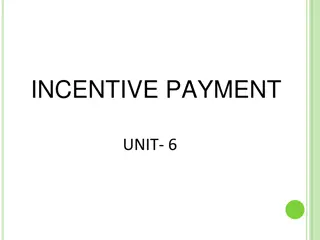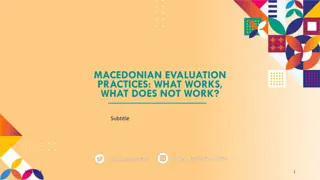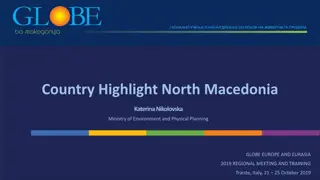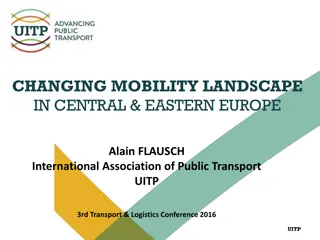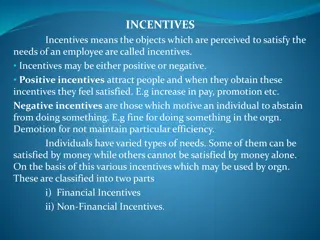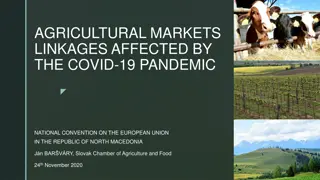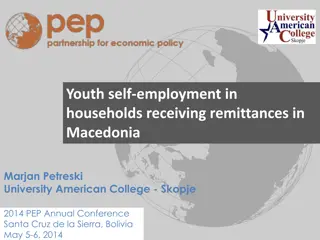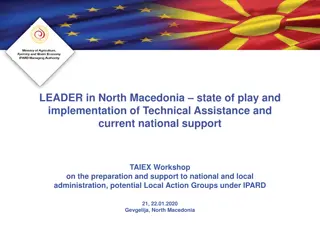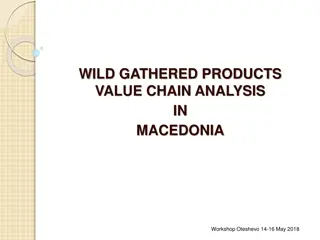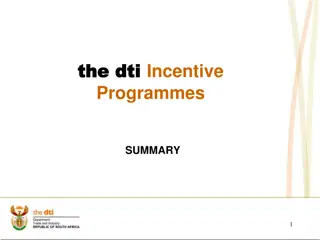Investment Profile of Eastern Macedonia-Thrace: Opportunities and Incentives
Eastern Macedonia and Thrace, a region in Greece, offers a range of investment opportunities across various sectors such as agriculture, manufacturing, trade, and more. With a strategic location and a skilled workforce, the region presents attractive incentives for investors looking to establish a presence. The region covers 14,157 sq. km and features favorable demographics, workforce statistics, and significant performance indicators in industries like manufacturing, construction, and information and communication. Explore the potential for growth and development in Eastern Macedonia and Thrace.
Download Presentation

Please find below an Image/Link to download the presentation.
The content on the website is provided AS IS for your information and personal use only. It may not be sold, licensed, or shared on other websites without obtaining consent from the author.If you encounter any issues during the download, it is possible that the publisher has removed the file from their server.
You are allowed to download the files provided on this website for personal or commercial use, subject to the condition that they are used lawfully. All files are the property of their respective owners.
The content on the website is provided AS IS for your information and personal use only. It may not be sold, licensed, or shared on other websites without obtaining consent from the author.
E N D
Presentation Transcript
Region of Eastern Macedonia-Thrace Investment Profile November 2017
Contents 1. Profile of the Region of Eastern Macedonia-Thrace 2. Eastern Macedonia-Thrace competitive advantages 3. Investment Opportunities
1. Profile of the Region of Eastern Macedonia-Thrace 2. Eastern Macedonia-Thrace competitive advantages 3. Investment Opportunities 4. Investment Incentives
The Region of Eastern Macedonia and Thrace : Quick facts (I) Eastern Macedonia and Thrace consists of the northeastern parts of the country, and is divided into the Macedonian regional units of Drama, Kavala and Thasos and the Thracian regional units of Xanthi, Rhodope, Evros and Samothrace The Region covers 14.157 sq. km corresponding to 10,7% of the total area of Greece. It borders Bulgaria and Turkey to the north, the prefecture of Serres to the west and the Thracian Sea to the south The Prefecture of Evros, the borderline of Greece is the largest prefecture of Thrace. It borders Bulgaria to the north and northeast and Turkey to the East, having the river Evros, The island of Samothrace also belongs to the prefecture of Evros The prefecture of Rhodope lies in central Thrace covering 2,543 sq. km. The capital of the prefecture is Komotini, the administrative seat of the Region of East Macedonia and Thrace. The prefecture of Xanthi covers 1,793 sq. km., of which 27% is arable 4. Investment Incentives land, 63% forests and 3% meadows in the plains The Prefecture of Kavala is in East Macedonia and covers 2,110 sq. km. The islands of Thassos and Thassopoula also belong to the prefecture The prefecture of Drama is well-known for the verdant mountain ranges, the water springs, the rare flora and fauna. The mountainous regions cover 63,5% of the area, the semi-mountainous 25,30%
The Region of Eastern Macedonia and Thrace : Quick facts (II) Demographics and Workforce quick facts Population: 608.182 (2011) 5.6% of the total Greek population Main macroeconomic data of the Region of Eastern Macedonia and Thrace 2012 7,579 12,403 2013 7,004 11,498 2014 6,903 11,366 2015 n.a. n.a. 2016 n.a. n.a. GDP* GDP per capita** 4. Investment Incentives Gross fixed capital formation* 958 1,067 938 n.a. n.a. Unemployment Rate (%) 22.8 26.7 24.1 23.4 22.8 *In million euros **In euros Source: Hellenic Statistical Authority
Significant performance indicators Gross Value Added by Industry 2014 (Region of Eastern Macedonia and Thrace) Industry/ Sector Gross Value Added (amount in million euro) 433 % in total GVA of the Region Agriculture, Forestry and Fishing 7.1 Mining, energy, water supply and waste management Manufacturing 248 4.1 689 180 1,261 11.3 2.9 20.7 Construction Trade, transportation and storage, accommodation and food service activities Information and Communication 96 1.6 Financial and Insurance activities 162 2.6 4. Investment Incentives Scientific, administrative and support service activities Public administration, education, health and social work activities Real Estate activities 772 125 12.7 2.0 1,926 31.6 Arts, recreation and other service activities Total 207 3.4 6,098 100 Source: Hellenic Statistical Authority
1. Profile of the Region of Eastern Macedonia-Thrace 2. Eastern Macedonia-Thrace competitive advantages 3.Investment Opportunities 4. Investment Incentives
Natural Treasures The natural environment in the Region of Eastern Macedonia and Thrace is characterized by a variety of habitats, which host a great number of rare species, and by unique biotopes There are many significant protected reserves (the Elati forest, the Frakto forest, the only virgin forest in Greece, the Porto Lagos lagoon, the Evros Delta, the Dadia forest) The natural environment of the Region of Eastern Macedonia and Thrace is protected by the Ramsar Treaty and by the E.U. initiatives CORINE and NATURA 2000 The Rhodope mountain range, the forest complex in Drama and the riparian forest of Nestos, although they have been degraded, continue to be the most significant biotopes The Evros Delta, the Nestos Delta and the lake ecosystems are sanctuaries for a large number of different species of breeding or wintering birds, which is an indication of the good preservation of the natural environment and the diversity of the biotopes
Agricultural Production The primary sector in Eastern Macedonia and Thrace, especially agriculture, plays a key role in GDP. An important advantage to the economic growth of the region is added by the forests, especially the forests in the Drama prefecture The arable plains (40% of them are irrigated) are cultivated intensively, producing tobacco, grains and tomato In the Nestos Delta the agriculture of asparagus and rice is widespread. In north Evros and in Tychero the asparagus plant is systematically cultivated The beans and the potatoes of Kato Nevrokopi are the most well known products of the area In recent years the vineyards in the Prefecture of Drama have significantly developed for the production of wines of appellation, achieving international recognition Agriculture is the main revenue in the Prefecture of Xanthi, as 45% of the population works in this sector. cotton, corn,
Education and research () Democritus established in July 1973 and started operating during the academic year 1974-1975. It was named "Democritus" in honor of the ancient Greek philosopher Democritus, who hailed from the town of Abdera in Thrace The administration of DUTH is headquartered in Komotini, which is the capital city of the Administrative Region of Eastern Macedonia and Thrace. The University is currently operating eight Faculties and nineteen Schools in four cities of Thrace - eight in Komotini, five in Xanthi, four in Alexandroupolis and two in Orestiada Overall, more than 15,000 students are studying at DUTH at undergraduate and post-graduate level The University plays an important role in strengthening the national and cultural identity of the region of Thrace, and contributes to the high level of education in Greece University of Thrace (DUTH) was Source: http://duth.gr/first/university/index.en.shtml
Education and research () School of Agricultural Sciences & Forestry (Alexandroupolis) Department of Agricultural Development (Orestiada Evros) Department of Forestry and Management of the Environment and Natural Resources (Orestiada Evros) School of Education Science (Alexandroupolis Evros) Department of Education Sciences in Early Childhood (Alexandroupoli) Primary Level Education School (Alexandroupoli) School of Classics & Humanities Studies (Komotini) Department of Greek Literature (Komotini) Department of Language, Literature and Civilization of the Black Sea Countries (Komotini) History & Ethnology School (Komotini) School of Social, Political and Economic Sciences (Komotini) Department of Social Administration (Komotini) Department of Economics (Komotini) Law School (Komotini) Department of Hellenic Studies (Komotini) Source http://duth.gr/department/index.en.shtml
Education and research (I) School of Engineering (Xanthi) Department of Architectural Engineering (Xanthi) Department of Electrical & Computer Engineering (Xanthi) Department of Production and Management Engineering (Xanthi) Department of Environmental Engineering (Xanthi) Department of Civil Engineering (Xanthi) School of Health Sciences (Alexandroupolis) Medical Department (Alexandroupolis) Department of Molecular (Alexandroupolis) Physical Education & Sports Science Faculty (Komotini) Department of Physical Education & Sports Science Eastern Macedonia and Thrace Institute of Technology (Kavala) School of Technological Engineering School of Business and Economics School of Agricultural Technology School of Health and Welfare Biology & Genetics Source http://duth.gr/department/index.en.shtml
Transport Infrastructure The Region is served by two airports, two international ports the Egnatia Road that connects the port of Igumenitsa in Epirus with Alexandroupoli in Thrace and the railway network that passes through the entire region Airports 1. Alexandroupolis Dimokritos Airport - Alexandroupolis 2. Kavala Megas Alexandros Airport - Keramoti Ports 1. Alexandroupolis 2. Kavala
Large Infrastructure Projects (under development) - HRADF he airport of Kavala is including in the cluster A of regional airports that HRADF concluded successfully international tender process in the granting of the right of concession for the development and operation of 14 regional airports in Greece.In particular, two 40-year concessions to upgrade, maintain, manage and operate two clusters of seven regional airports (per each) have been conferred to a consortium of companies consisting of Fraport AG Frankfurt Airport Services Worldwide and Slentel Limited of Copelouzos Group. The portfolio of the Hellenic Republic includes the ports of Alexandroupolis and Kavala. Particularly, HRADF holds 100% of the shares in the port and has the right to operate it until 2042. The Hellenic Republic is in the process of evaluating the most appropriate approach for the development of these ports. Source: www.hradf.com
Transnational "Sea2Sea" mega railway project Developments on the important transnational project "Sea2Sea", concerning the upgrade of the railway line, connecting Thessaloniki-Kavala-Alexandroupolis-Ormenio with the Bulgarian ports of Burgas, Varna and the river delta of Danube The implementation and upgrade of the Eastern "Railway Egnatia", costing approximately 2.5nbn euros, of which 1.7bn concerns the construction of the new "coastal" line design, electrified for the whole Thessaloniki-Kavala-Xanthi section, which promises to reduce the journey time by about 3 hours as well as the upgrade and electrification of Xanthi-Alexandroupoli-Ormenio section Source: www.ypodomes.com
Eastern Macedonia-Thrace offers an interesting environment for investment... Eastern Macedonia-Thrace advantages ..are enhanced by investment incentives Eastern Macedonia-Thrace boasts a number Under the new Investment Incentives Law L.4399/2016, Thessaly enjoys attractive investment incentives varying of comparative advantages related to its: from 35% to 55% of the total investment cost, according strategic location, bordering Bulgaria on the to the size of the company and the region of the country North and Turkey on the East in which the project will be implemented. The aid schemes of the Law include: Great existing transport infrastructure 1) Tax exemptions A widespread network of industrial areas 2) Cash grants Academic-R&D infrastructure & dynamics 3) Leasing subsidies Tourism and Cultural sites 4) Wage costs subsidy 5) Stable corporate tax rate for 12 years Opportunities in the renewable energy 6) Financing of business risk through loans or equity sources 7) Fast track licensing Opportunities from the very rich subsoil (mineral reserves in gold, copper, silver, etc)
Operational Program Eastern Macedonia-Thrace 2014-2020 Expected impacts Investment incentives quick facts Support of more than 370 SMEs and creation of some 860 employment positions Cooperation of 300 enterprises with research institutes, promotion of innovation and ICT and start-ups creation Reduce CO blueprint of public buildings by 9,000 tonnes, produce 36,000 tonnes/year of geothermy and add 10,000 tonnes of waste in the recycling process Increase by 2,000/year expected visitors in the region and construct or upgrade 80 km of roads Cover 250,000 additional inhabitants with improved healthcare services and increase capacity of supported childcare or education infrastructure by 4,000 people Support some 55 social enterprises and benefit some 5,000 disadvantaged persons with health and social care services Promote Roma integration through Integrated Territorial Investments New Investment law L.4399/2016: Subsidies of up to 55% for business plans Regional Development Fund (ERDF): 352,936,804.00 European Social Fund (ESF): 53,254,664.00 Funding Priorities strengthen the links between R&D and enterprises, focus on the development of economic activities identified by RIS3 and enhance extroversion explore geothermy, increase of energy efficiency in buildings, address specific risks, in particular floods and coastal erosion, improve water management as well as solid waste and water waste management, promote natural and cultural heritage and reinforce accessibility in the region investments in education, professional as well as in health and social care infrastructures improving employment and skills in the areas of the regional RIS3 while improving access to employment for disadvantaged people, combatting discrimination, promoting social enterprises and access to health services provision of technical assistance Source: http://ec.europa.eu
1. Profile of the Region of Eastern Macedonia-Thrace 2. Eastern Macedonia-Thrace competitive advantages 3. Investment Opportunities 4. Investment Incentives
Reasons to Invest in Thessaly Strategic location: Bordering Bulgaria on the North and Turkey on the East Natural and cultural treasures: Unique natural beauty combined with long history, religious treasures and friendly people A production locomotive : The primary sector, especially agriculture, plays a key role in GDP. The arable plains (40% of them are irrigated) are cultivated intensively, producing cotton, corn, tobacco, grains and tomato etc Tourism Tourist destination: Popular destination offering an upgraded and diversified tourist product that includes hiking in the mountains, sightseeing, local gastronomy, sea sports etc Manufacturing Industrial sites complex:The region disposes over five industrial zones, one for each prefecture, providing land and easy licensing procedure for industrial use Food & Beverage Potential in Renewable energy:Thrace has a very strong wind potential Transport infrastructure: The region disposing over substantial infrastructure, capable to support wide investment activity in the area Energy Urban infrastructure: The urban infrastructure is well developed, including a sufficient number of hospitals, both private and public, courts of various levels, banks, telecommunications, primary and secondary schools, etc Support of the local Authorities: The consistent and unwavering support of the local Authorities , as well as the hospitable and business
Tourism Tourism
Tourism in Eastern Macedonia-Thrace: Facts and figures (I) Tourism data for the Region of Eastern Macedonia-Thrace (2016) Region and Prefecture 5***** 4**** TOTAL Hotels Rooms Beds Hotels Rooms Beds Hotels Rooms Beds Total Greece 444 67407 137210 1412 104562 203203 9730 407146 788553 Eastern Macedonia and Thrace Region 11 1035 2073 29 1910 3850 379 10833 21324 Rodopi 0 0 0 6 317 645 22 831 1613 Drama 1 73 147 3 173 365 20 587 1173 Evros 3 384 762 2 142 293 62 1979 3810 Thassos 3 272 561 10 882 1828 204 5067 10148 Kavala 2 179 359 5 328 573 51 1644 3132 Xanthi 2 127 244 3 68 146 20 725 1448 Source: Hellenic Statistical Authority
Tourism in Tourism in Eastern Macedonia-Thrace: Facts and figures (II) Tourism data for the Region of Eastern Macedonia-Thrace(2016) HOTELS EXCEPT CAMPINGS REGION AND PREFECTURE 2015 2016 TOURIST ARRIVALS BEDS TOURIST ARRIVALS BEDS GREEK FOREIGN TOTAL GREEK FOREIGN TOTAL TOTAL GREECE 5,744,134 12,734,567 18,478,701 737,326 5,996,434 12,999,947 18,996,381 746,630 EASTERN MACEDONIA AND THRACE REGION 336,095 270,610 606,705 22,183 337,191 268,807 605,998 22,333 Rodopi 68,001 16,400 84,401 1,482 55,975 15,282 71,257 1,464 Drama 25,610 2,468 28,078 1,177 29,772 3,780 33,552 1,224 Evros 91,142 46,496 137,638 4,696 90,739 42,734 133,473 5,202 Thassos 22,864 106,585 129,449 10,355 26,280 115,248 141,528 9,999 Kavala 69,148 89,297 158,445 3,068 69,815 81,805 150,870 3,018 Xanthi 59,330 9,364 68,694 1,405 64,610 9,958 74,568 1,426 Source: Hellenic Statistical Authority
Major tourism attractions Kavalla Xanthi Samothrace Thasos Ancient theater of Filippi Nestos Delta Frakto forest Lake Vistonida
Numerous touristic activities The region offers almost all types of touristic activities: Cultural tourism (Archaeological Museum of Drama, Archaeological Museum of Philippi, Archaeological Museum of Kavala, Archaeological Museum of Limenas in Thassos) Religious tourism (the monastery of Ikosifinissa at Mount Pangaion, the monastery of Agios Syllas, the Baptistery of Agia Lydia, the Taxiarches Monastery, the Panagia Kalamous Monastery) Conference and exhibition tourism (Conference centre at Lydia, Exhibition Centre Nea Karvali, Exhibition Centre in Komotini, Foundation of Thracian Art and Tradition, whereas hotels in every city provide facilities for organising various events) Ecotourism ( the Elati forest, the Frakto forest, the Rhodope mountain range, the Nestos Delta, the Evros Delta, the Pomak villages, beautiful beaches on the coastline, impressive mountains and forests) Therapeutic tourism (mud baths at Krinides, spa at Thermae and Potamia in Xanthi, in Samothrace and at Traianoupolis) Agrotourism (numerous agrotouristic farms and guest houses have developed recently in all the prefectures of the region)
Investment opportunities in various tourism segments Cruises and Sea tourism Eco Tourism Cultural and religious tourism Development of existing state & private assets Therapeutic tourism
Tourism: Indicative Investment Projects Enterprise Greece maintains a portfolio of investment projects in all business sectors and Regions of Greece. As far as Tourism in Eastern Macedonia-Thrace is concerned the portfolio of Enterprise Greece includes: Land plots that could be used for tourism development Mixed use tourism projects under development Tourism facilities for sale or looking for co investors
Industrial activity Since the 1980s, Greek industrial activity has been decentralized and a dynamic industrial complex was created in East Macedonia and Thrace based on: food and beverage production, textile and clothing, furniture, as well as intermediary industries of paper pulp, chemicals, and plastics. A range of companies located to the industrial areas of Xanthi, Komotini, etc. Prefecture of Kavala: In Kavala operated the only Phosphoric Fertilizer industry and in the industrial zone of the city there are marble industries. Both the industry of fertilizers and of phosphoric ammonium sulphate, as well as the industry of tobacco processing, contribute greatly to the economy of the prefecture Prefecture of Xanthi: The prefecture has a developed industrial zone, with sugar factories, tobacco factories, flour industries and textile factories Prefecture of Rodophe: An industrial zone expands to the east of Komotini with fodder factories, food and clothes industries, aluminum industry, while further to the east there is a timber industry and a thermal power station. The International Exhibition Centre of East Macedonia and Thrace is located in the industrial area.
Mineral wealth and significant resources Eastern Macedonia-Thrace is known, from the ancient years, for its rich mineral wealth: In the prefecture of Drama the marble quarries are among the largest and most developed in Greece. Marble is exported to Arab countries, Europe, USA and Japan. Moreover, there are important mineral resources of manganese at the foot of Mt Phalakro, uranium deposits and industrial minerals in Paranesti and a lignite field has been recently located in Mavrolefki. The subsoil of the prefecture contains also significant resources of industrial minerals, lignite deposits and turf, mainly in the flat land of the south The subsoil of the prefecture of Kavala is rich in iron ore (in Thassos) and in marble (near the village Limnias) The subsoil of the prefecture of Xanthi and Rhodope is rich in mineral wealth (marble, granite, graphite, geothermal field)
Investment opportunities: Manufacturing sector A widespread network of industrial areas that provide the required infrastructure for the development of new and existing companies Unique opportunities for the creation of clusters of companies not only in Greece but also in the bordering countries, which could provide the cost competitive advantage Very rich subsoil of the Region that provides mineral reserves in gold, copper, silver, etc Marble quarries are among the largest and most developed in Greece Strong industry of tobacco processing Incentives of the New Development Law L.4399/2016
Renewable Energy Sources Unexploited Capacity Region of Eastern Macedonia-Thrace has unexploited capacity in Wind energy and Geothermal production As shown in the attached Maps the potential is tremendous. Solar energy capacity Wind energy capacity
Investment opportunities in Greece: RES National Targets and Performance RES technology Target 2020 Capacity 2016 Wind 7500 2047,17 Solar (PV s) 4200 2093,52 Small Hydro 350 223,18 Even during the economic crisis in Greece, the RES sector was one of the growing economic sectors where investments were made and employment was created Biomass 350 57,68 Geothermal 120 0 Highly exploited area with growing capacity Region of Eastern Macedonia-Thrace Wind Parks: 304,35 MW Small Hydro: 3,03 MW Biomass: 0,80 MW Geothermal: 36,15 MW PV s: 214,86 MW The Greek RES market has grown with a very strong pace. Total installed capacity stood at 1,06 GW in 2008and 4,6 GW in2015, 334% increase within the last 7 years! Source: www.lagie.gr
Food & Agriculture The home of the Mediterranean diet is becoming a favourite with foodies from around the world, who enjoy the highest quality ingredients on offer
Food & Beverage: An overview (I) Key Area Products and some unique characteristics Prefecture of Drama: The economy of the prefecture relies mainly on agriculture ,in the plains of the southern part of the prefecture grains, cotton, tomatoes, tobacco, grapevines, fruits and vegetables are cultivated. The agriculture exploits to the fullest the water resources Prefecture of Evros: The economy of Evros relies mainly on agriculture grains, pulses, fruits and vegetables are cultivated, as well as the systematic cultivation of certain plants used in industry such as the sunflower and the sesame. Production of sugar canes supplies the sugar factory in north Evros and asparagus plant is systematically cultivated. Mulberry trees, almond trees, apple trees and pear trees are also cultivated, whereas in Samothrace olive trees grow
Food & Beverage: An overview (II) Key Area Products and some unique characteristics Prefecture of Kavala: Fish is exported and traded in markets throughout Greece and abroad. In agriculture , tobacco, is cultivated but also grains, rice, pulses, kiwi, cotton, grapes and vegetables. There are also olive groves, producing large quantities of olive oil, vineyards and cultivation of asparagus and rice Prefecture of Xanthi: The region of Xanthi produces the renowned aromatic tobacco, cotton, wheat, corn, kiwi and vegetables are also cultivated in the plain. In the Vistonic bay fish is abundant and in the lake of Porto Lagos there are fish farms.Xanthi is famous for the local sweets, such as carioca, soutzuk loukum, halvas, syrup sweets, etc Prefecture of Rhodope: Agriculture dominates the prefecture of Rhodope, cotton, tobacco, wheat, corn, sugar cane, sunflower, cherry, kiwi and vegetables are the basic agricultural products
Investment opportunities: Food & Beverage Recent Developments/New Opportunities Rural Development Programme (RDP) 2014-2020 focuses mainly on strengthening farm viability and competitiveness, preserving and enhancing ecosystems and fostering the local development in rural areas. Investments inwheat, tobacco, cotton, asparagus, potatoes, wine,rice and kiwi Further Investments in livestock farming and fish farming Demand for ecologically produced agricultural products rising world wide
Leading Companies in Eastern Macedonia and Thrace Source: ICAP
Enterprise Greece Enterprise Greece is the new, official agency of the Greek State, under the supervision of the Ministry for Economy and Development. Its mandate is to showcase Greece as an outstanding destination for investment and to promote the highly competitive products and services produced in Greece for export. Investment Trade Attracts, welcomes, promotes, supports and retains investment in Greece Promotes Greece internationally as an attractive investment destination Accepts applications, evaluates and supports Greece s Strategic Investment (Fast Track) projects Provides investors with the Investor Ombudsman service Informs investors of Greece s institutional, tax, legal, and financial framework Supports investors in accessing finance Partners with related organisations, domestic and international, to promote Greece as an investment destination Promotes the export of Greek products and services internationally through marketing, events, and trade centres Supports Greek producers and service providers with guidance, assistance, information and resources to better reach international markets Connects Greek exporters and entrepreneurs with potential partners around the world Organizes the presence of Greek companies at conferences, fora, exhibitions and trade shows in global markets Hosts foreign delegations and visitors to Greece Partners with related organisations, domestic and international, to promote Greece s export market
Your partner for growth 109 Vasilissis Sophias Ave. 115 21 Athens, Greece T. 0030 210 33 55 700 F. 0030 210 32 42 079 E. info@enterprisegreece.gov.gr
